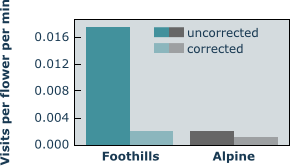Limitations to seed set?
Alpine flowers wait for their pollinators
Although pollination seems not to be limited by the availability of potential pollinators, cold weather and strong winds at high altitudes may affect pollinator visiting rates. Pollinators do not fly when wind speed is below 4 ms-1.
Visiting rates of flowers in the lowland are usually between one and several visits per flower and hour. At high altitudes visiting rates are much lower. In the Central Andes mean visiting rates in Ranunculus acris (Ranunculaceae) were only 0.25 at middle and 0.19 at high elevations. Similar low visiting rates were observed for Eritrichium nanum at 3000 m in the Swiss Alps.
Alpine plants may, however, compensate for such low visiting rates by:
- A significantly longer stigma receptivity; for instance, in the Chilean Andes 9 days at 3550 m instead of 4.1 days at 2310 m (Arroyo et al. 1981).
- Significantly larger deposition of pollen per visit because of efficient pollination by bumblebees (Bingham 1998).
Pollination in alpine and lowland plants is thus more comparable than would be expected from the lower insect diversity and limited pollinator activity alone. Increased floral longevity is probably an important adaptation to low pollinator visiting rates in alpine habitats.
There are many other ways by which seed set may be limited in the cold
- Low temperature may constrain pollen tube germination and pollen tube growth and thereby reduce the success of fertilisation.
- Low temperature may reduce the speed of seed maturation and increase the risk of the abortion rate of developing seeds.
- Sub-optimal temperatures may limit photosynthetic activity and thereby reduce the amount of resources to be allocated to seeds.
Longer stigma receptivity can largely compensate for low pollinator visiting


